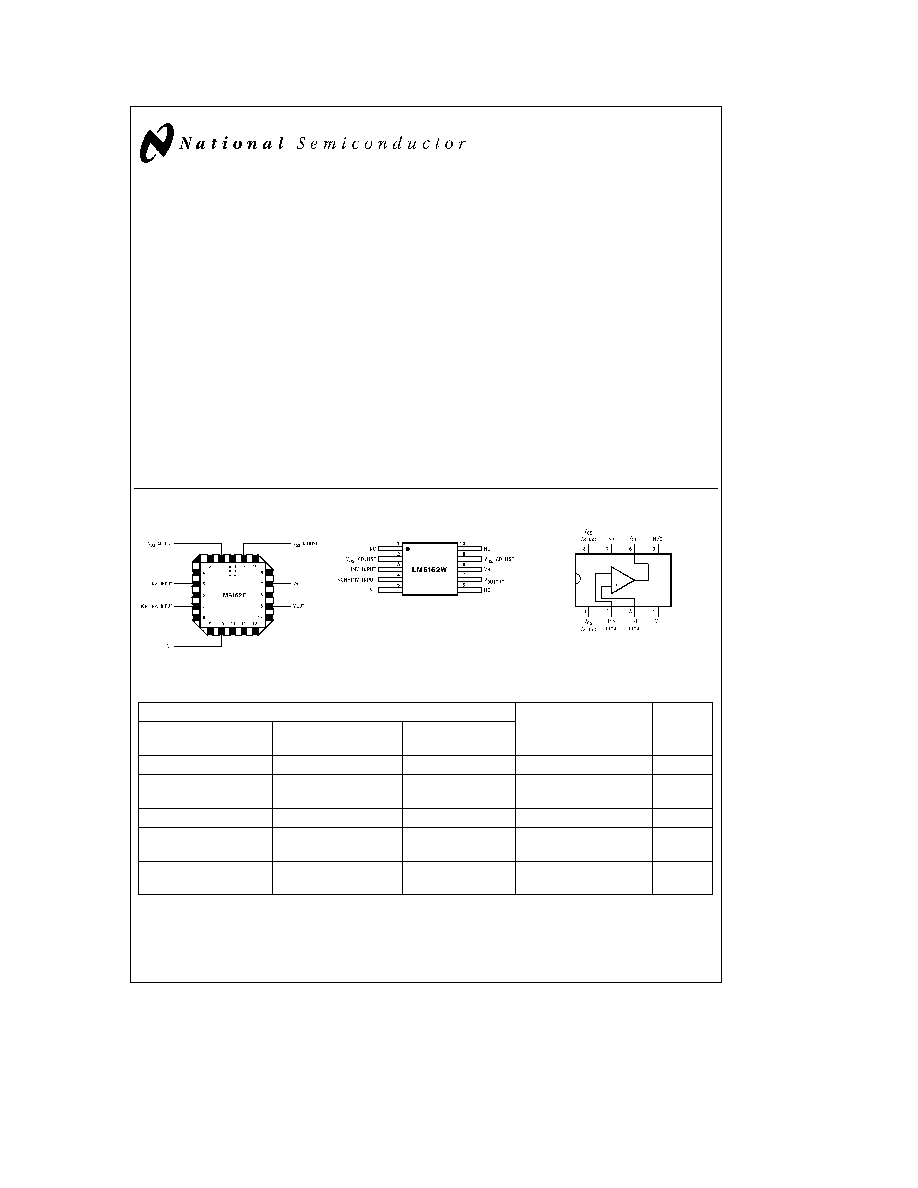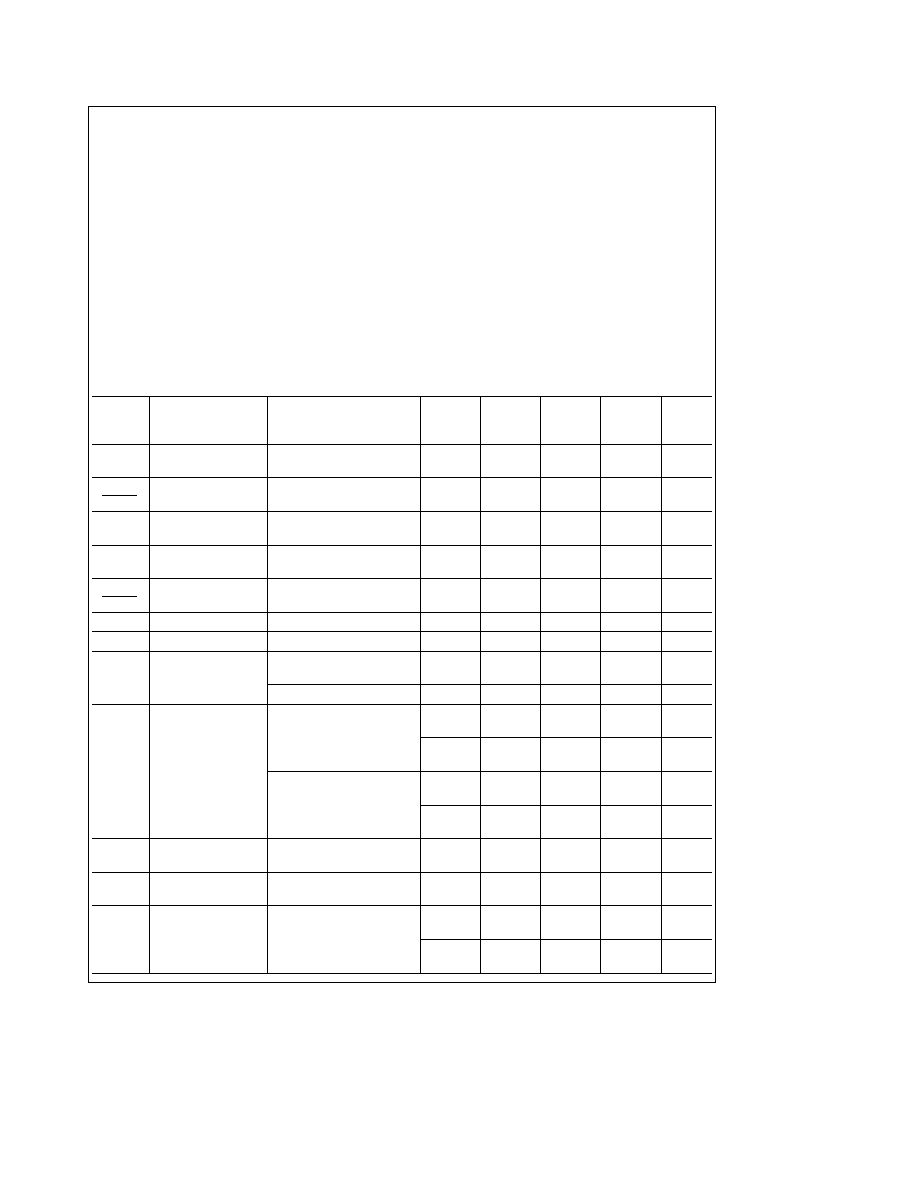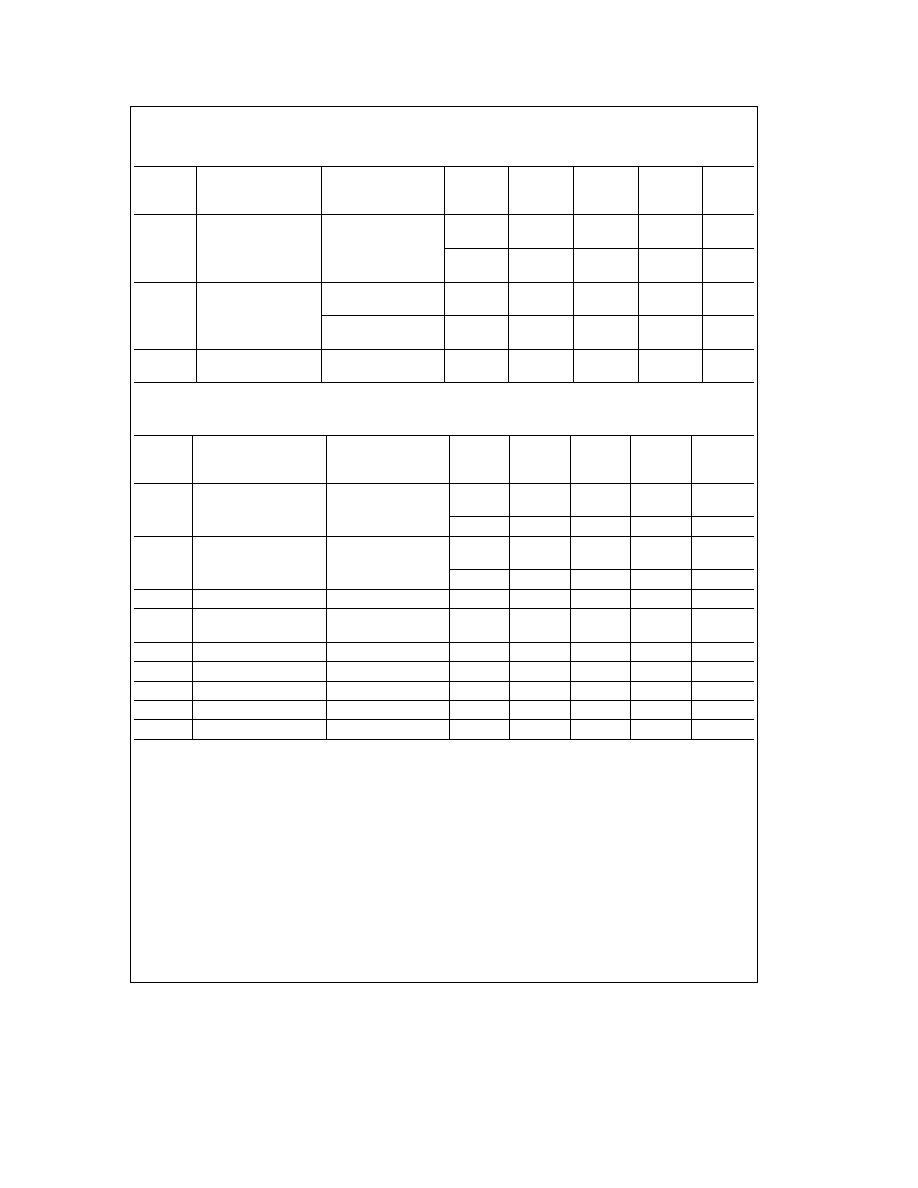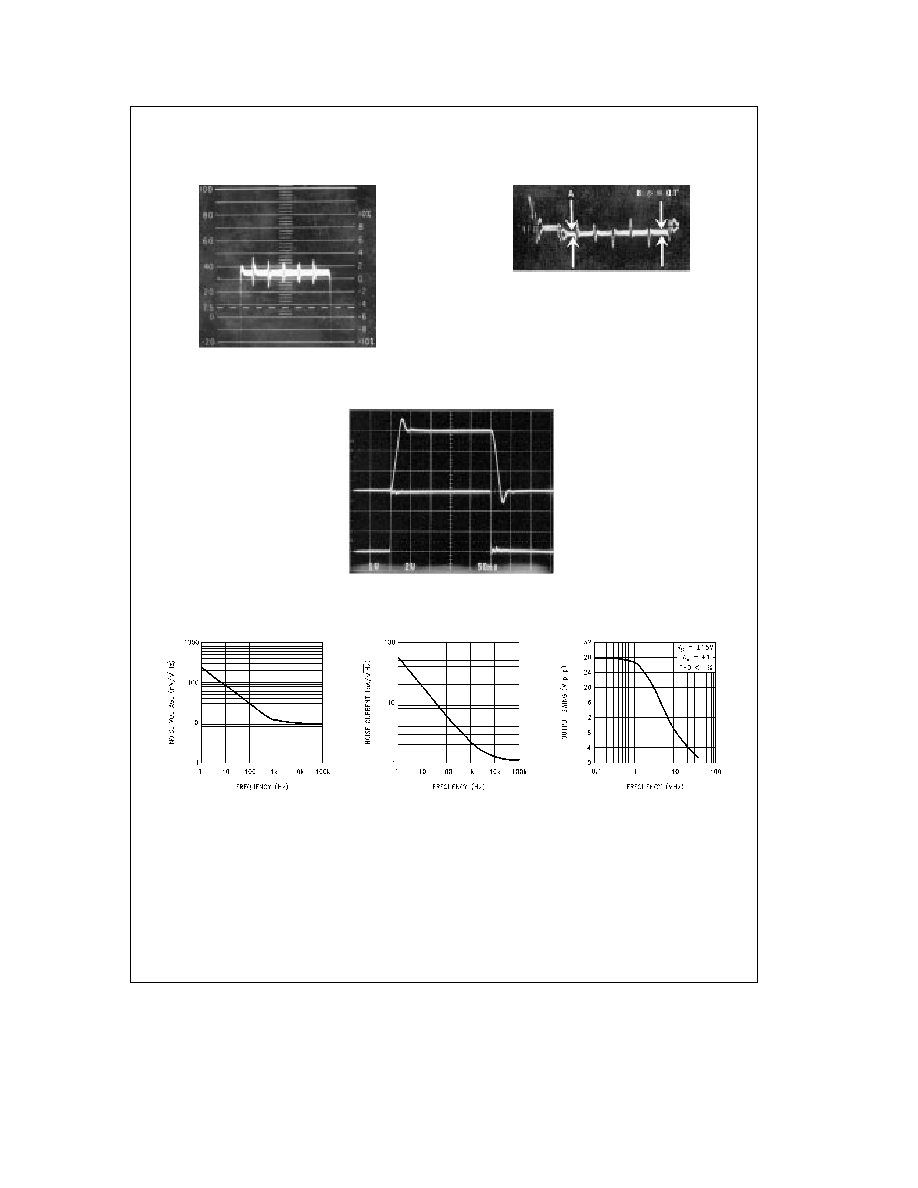
TL H 11061
LM6162LM6262LM6362
High
Speed
Operational
Amplifier
September 1995
LM6162 LM6262 LM6362
High Speed Operational Amplifier
General Description
The LM6362 family of high-speed amplifiers exhibits an ex-
cellent speed-power product
delivering 300 V ms and
100 MHz gain-bandwidth product (stable for gains as low as
a
2 or
b
1) with only 5 mA of supply current Further power
savings and application convenience are possible by taking
advantage of the wide dynamic range in operating supply
voltage which extends all the way down to
a
5V
These amplifiers are built with National's VIP
TM
(Vertically
Integrated PNP) process which provides fast transistors that
are true complements to the already fast NPN devices This
advanced junction-isolated process delivers high speed per-
formance without the need for complex and expensive di-
electric isolation
Features
Y
High slew rate
300 V ms
Y
High gain-bandwidth product
100 MHz
Y
Low supply current
5 mA
Y
Fast settling time
120 ns to 0 1%
Y
Low differential gain
k
0 1%
Y
Low differential phase
k
0 1
Y
Wide supply range
4 75V to 32V
Y
Stable with unlimited capacitive load
Y
Well behaved easy to apply
Applications
Y
Video amplifier
Y
Wide-bandwidth signal conditioning for image process-
ing (FAX scanners laser printers)
Y
Hard disk drive preamplifier
Y
Error amplifier for high-speed switching regulator
Connection Diagrams
20-Lead LCC
TL H 11061 ≠ 14
Top View
See NS Package Number E20A
10-Pin Ceramic Flatpak
TL H 11061 ≠ 15
Top View
See NS Package Number W10A
TL H 11061 ≠ 2
See NS Package Number N08E
M08A or J08A
Temperature Range
Package
Drawing
NSC
Military
Industrial
Commercial
b
55 C
s
T
A
s
a
125 C
b
25 C
s
T
A
s
a
85 C
0 C
s
T
A
s
a
70 C
LM6162N
LM6262N
LM6362N
8-Pin Molded DIP
N08E
LM6162J 883
8-Pin Ceramic DIP
J08A
5962-9216501PA
LM6262M
LM6362M
8-Pin Molded Surface Mt
M08A
LM6162E 883
20-Lead LCC
E20A
5962-92165012A
LM6162W 883
10-Pin Ceramic Flatpak
W10A
5962-9216501HA
VIP
TM
is a trademark of National Semiconductor Corporation
C1995 National Semiconductor Corporation
RRD-B30M115 Printed in U S A

Absolute Maximum Ratings
(Note 1)
If Military Aerospace specified devices are required
please contact the National Semiconductor Sales
Office Distributors for availability and specifications
Supply Voltage (V
a
≠ V
b
)
36V
Differential Input Voltage (Note 2)
g
8V
Common-Mode Input Voltage
(V
a
b
0 7V) to
(Note 3)
(V
b
a
0 7V)
Output Short Circuit to GND (Note 4)
Continuous
Soldering Information
Dual-In-Line Package (N)
Soldering (10 seconds)
260 C
Small Outline Package (M)
Vapor Phase (60 seconds)
215 C
Infrared (15 seconds)
220 C
See AN-450 ``Surface Mounting Methods and Their Effect
on Product Reliability'' for other methods of soldering sur-
face mount devices
Storage Temperature Range
b
65 C
s
T
J
s
a
150 C
Max Junction Temperature
150 C
ESD Tolerance (Note 5)
g
1100V
Operating Ratings
Temperature Range (Note 6)
LM6162
b
55 C
s
T
J
s
a
125 C
LM6262
b
25 C
s
T
J
s
a
85 C
LM6362
0 C
s
T
J
s
a
70 C
Supply Voltage Range
4 75V to 32V
DC Electrical Characteristics
These limits apply for supply voltage
e
g
15V V
CM
e
0V and R
L
t
100 kX unless otherwise specified Limits in standard
typeface are for T
A
e
T
J
e
25 C limits in boldface type apply over the Operating Temperature Range
(Note 7)
Typical
LM6162
LM6262
LM6362
Symbol
Parameter
Conditions
Limit
Limit
Limit
Units
(Note 8)
(Note 8)
(Note 8)
V
OS
Input Offset Voltage
g
3
g
5
g
5
g
13
mV
g
8
g
8
g
15
max
D
V
OS
D
Temp
Input Offset Voltage
7
m
V C
Average Drift
I
bias
Input Bias Current
2 2
3
3
4
m
A
6
5
6
max
I
OS
Input Offset Current
g
150
g
350
g
350
g
1500
nA
g
800
g
600
g
1900
max
D
I
OS
D
Temp
Input Offset Current
0 3
nA C
Average Drift
R
IN
Input Resistance
Differential
180
kX
C
IN
Input Capacitance
2 0
pF
A
VOL
Large Signal
V
OUT
e
g
10V R
L
e
2 kX
1400
1000
1000
800
V V
Voltage Gain
(Note 9)
500
700
650
min
R
L
e
10 kX
6500
V V
V
CM
Input Common-Mode
Supply
e
g
15V
a
14 0
a
13 9
a
13 9
a
13 8
V
Voltage Range
a
13 8
a
13 8
a
13 7
min
b
13 2
b
12 9
b
12 9
b
12 9
V
b
12 7
b
12 7
b
12 8
max
Supply
e a
5V
4 0
3 9
3 9
3 8
V
(Note 10)
3 8
3 8
3 7
min
1 6
1 8
1 8
1 9
V
2 0
2 0
2 0
max
CMRR
Common-Mode
b
10V
s
V
CM
s
a
10V
100
83
83
76
dB
Rejection Ratio
79
79
74
min
PSRR
Power Supply
g
10V
s
V
S
s g
16V
93
83
83
76
dB
Rejection Ratio
79
79
74
min
V
O
Output Voltage
Supply
e
g
15V R
L
e
2 kX
a
14 2
a
13 5
a
13 5
a
13 4
V
Swing
a
13 3
a
13 3
13 3
min
b
13 4
b
13 0
b
13 0
b
12 9
V
b
12 7
b
12 8
b
12 8
max
2

DC Electrical Characteristics
(Continued)
These limits apply for supply voltage
e
g
15V V
CM
e
0V and R
L
t
100 kX unless otherwise specified Limits in standard
typeface are for T
A
e
T
J
e
25 C limits in boldface type apply over the Operating Temperature Range
(Note 7)
Typical
LM6162
LM6262
LM6362
Symbol
Parameter
Conditions
Limit
Limit
Limit
Units
(Note 8)
(Note 8)
(Note 8)
V
O
Output Voltage Swing
Supply
e a
5V and
4 2
3 5
3 5
3 4
V
R
L
e
2 kX (Note 10)
3 3
3 3
3 3
min
1 3
1 7
1 7
1 8
V
2 0
1 9
1 9
max
I
OSC
Output Short
Sourcing
65
30
30
30
mA
Circuit Current
20
25
25
min
Sinking
65
30
30
30
mA
20
25
25
min
I
S
Supply Current
5 0
6 5
6 5
6 8
mA
6 8
6 7
6 9
max
AC Electrical Characteristics
These limits apply for supply voltage
e
g
15V V
CM
e
0V R
L
t
100 kX and C
L
s
5 pF unless otherwise specified Limits in
standard typeface are for T
A
e
T
J
e
25 C limits in boldface type apply over the Operating Temperature Range
(Note 7)
Typical
LM6162
LM6262
LM6362
Symbol
Parameter
Conditions
Limit
Limit
Limit
Units
(Note 8)
(Note 8)
(Note 8)
GBW
Gain-Bandwidth Product
f
e
20 MHz
100
80
80
75
MHz
55
65
65
min
Supply
e
g
5V
70
MHz
SR
Slew Rate
A
V
e a
2 (Note 11)
300
200
200
200
V ms
180
180
180
min
Supply
e
g
5V
200
V ms
PBW
Power Bandwidth
V
OUT
e
20 V
PP
4 5
MHz
t
s
Settling Time
10V step to 0 1%
100
ns
A
V
e b
1 R
L
e
2 kX
w
m
Phase Margin
A
V
e a
2
45
deg
Differential Gain
NTSC A
V
e a
2
k
0 1
%
Differential Phase
NTSC A
V
e a
2
k
0 1
deg
e
n
Input Noise Voltage
f
e
10 kHz
10
nV
S
Hz
i
n
Input Noise Current
f
e
10 kHz
1 2
pA
S
Hz
Note 1
Absolute maximum ratings indicate limits beyond which damage to the component may occur Electrical specifications do not apply when operating the
device beyond its rated operating conditions
Note 2
The ESD protection circuitry between the inputs will begin to conduct when the differential input voltage reaches 8V
Note 3 a)
In addition the voltage between the V
a
pin and either input pin must not exceed 36V
b) When the voltage applied to an input pin is driven more than 0 3V below the negative supply pin voltage a substrate diode begins to conduct Current
through this pin must then be kept less than 20 mA to limit damage from self-heating
Note 4
Although the output current is internally limited continuous short-circuit operation at elevated ambient temperature can result in exceeding the maximum
allowed junction temperature of 150 C
Note 5
This value is the average voltage that the weakest pin combinations can withstand and still conform to the datasheet limits The test circuit used consists of
the human body model 100 pF in series with 1500X
Note 6
The typical thermal resistance junction-to-ambient of the molded plastic DIP (N package) is 105 C W For the molded plastic SO (M package) use
155 C W All numbers apply for packages soldered directly into a printed circuit board
Note 7
Typical values are for T
J
e
25 C and represent the most likely parametric norm
Note 8
Limits are guaranteed by testing or correlation
Note 9
Voltage Gain is the total output swing (20V) divided by the magnitude of the input signal required to produce that swing
Note 10
For single-supply operation the following conditions apply V
a
e
5V V
b
e
0V V
CM
e
2 5V V
OUT
e
2 5V Pin 1 and Pin 8 (V
OS
Adjust pins) are each
connected to pin 4 (V
b
) to realize maximum output swing This connection will increase the offset voltage
Note 11
V
IN
e
10V step For
g
5V supplies V
IN
e
1V step
Note 12
A military RETS electrical test specification is available on request
3

Typical Performance Characteristics
R
L
e
10 kX T
A
e
25 C unless otherwise noted
Supply Voltage
Supply Current vs
Rejection Ratio
Common-Mode
Rejection Ratio
Power Supply
vs Supply Voltage
Gain-Bandwidth Product
vs Load Capacitance
Gain-Bandwidth Product
Rise and Fall Times
Propagation Delay
Supply Voltage
Slew Rate vs
Load Capacitance
Slew Rate vs
Load Capacitance
Overshoot vs
(Open-Loop)
Output Impedance
Load Resistance
Voltage Gain vs
Supply Voltage
Voltage Gain vs
TL H 11061 ≠ 3
4

Typical Performance Characteristics
(Continued)
R
L
e
10 kX T
A
e
25 C unless otherwise noted
Differential Gain
(Note)
TL H 11061 ≠ 4
Differential Phase
(Note)
TL H 11061 ≠ 5
Note
Differential gain and differential phase
measured for four series LM6362 op amps con-
figured with gain of
a
2 each in series with a
1 16 attenuator and an LM6321 buffer Error
added by LM6321 is negligible Test performed
using Tektronix Type 520 NTSC test system
Step Response Av
e a
2
TL H 11061 ≠ 6
TIME (50 ns div)
Input Noise Voltage
Input Noise Current
Power Bandwidth
TL H 11061 ≠ 7
Input
(1Vdiv)
Output
(2Vdiv)
5




